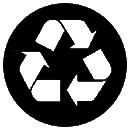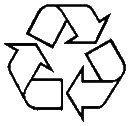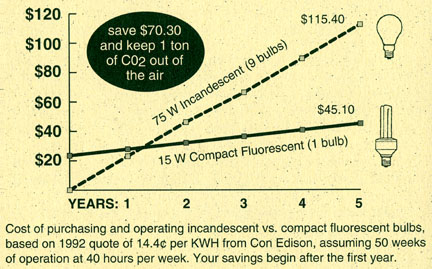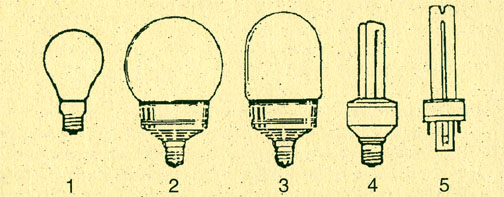|
THE
PRODUCTION OFFICE
The
central activity of the film business will take place in the office,
and so how you go about setting up your office will dictate the
eco-friendliness of the film as a whole. You should consider your
choices in all of these areas: paper, office supplies, energy consumption,
recycling, coffee, takeout, and bathroom and cleaning supplies.
PAPER
All paper
in your office should be made from recycled material, and should
be recycled. You are going to use a box (5000 sheets) of white 8.5"
x 11" paper by the time you finish your film. You should buy
this box now. Make sure the paper you use has .a high percent- age
of post-consumer fibers—10%
or more. You will be helping to make paper recycling
a viable
economic force. The bleaching process in all
paper production produces dioxin pollution. Dioxin, a
chlorinated compound, is on of the most toxic
substances known to man. Consider buying non-bleached papers.
COLORED PAPER is often used in film production
to indicate revisions in scripts, schedules and forms. If you think
your production will utilize a color-coding system, you will want
to get reams of recycled colored paper (blue, pink, green would
be sufficient 10 account for three revisions). Get a selection of
1000 sheets (two reams of paper) in each color. To buy in this small
quantity, you may need to locate a local recycled paper outlet.
• Colored paper is bleached, deinked and dyed. It is more
costly to process than white paper and fewer recycling plants are
willing to accept it.
• As an alternative to color-coding, consider dating tops
of pages instead, and distribute changes only to concerned parties.
REUSE PAPER: Buy a clipboard or 3-ring binder and
use it .as your notebook. Fill it with paper that is printed on
one side only, e.g. old versions of the script. You will save money
on legal pads and notebooks. Reuse paper also for fax cover sheets,
memos, test printing, and for rough drafts of scripts and letters.
SETTING
UP YOUR OFFICE FOR PAPER RECYCLING
|
| TREAT
PAPER AS A RESOURCE |
•
Assign paper some value in your mind. Ask yourself:
Is this memo or test print worth printing on a fresh
page?
• Incorporate paper conservation into your graphic
design choices: i.e. use space on a page wisely, print
double-sided, etc.
• Reuse paper products until they are used up.
• Recycle ail the paper you use, and buy recycled
paper products with a high
post-consumer content. |
| PAPER
PRODUCTS THAT CAN BE RECYCLED |
| IN
YOUR OFFICE SET UP SIX BINS AND LABEL THEM AS FOLLOWS: |
BIN
#1
WHITE PAPER
TYPING
BOND &PHOTOCOPYING
LASERPRINTER
ENVELOPE without windows or
labels |
BIN
#2
COLORED PAPER
TYPING
BOND & PHOTOCOPY
NOTEPAD
ENVELOPE without windows or labels
|
BIN
#3
COMPUTER PAPER
WHITE
COLOR BAR |
BIN
#4
NEWSPRINT PAPER
NEWSPAPERS
NEWSPRINT
PHONE BOOKS |
BIN#5
MAGAZINES
MAGAZINES
(GLOSSY) THEATER
SCHEDULES |
BIN#6
CARDBOARD
CORRUGATED |
|
| NOTE:
some paper recycling plants will accept "mixed
paper" which would greatly reduce your
obligation to sort, allowing you to combine,
for example, BINS 2-4. Find out your particulars
before setting up. |
|
| PAPER
PRODUCTS THAT CAN'T BE RECYCLED
|
BLUEPRINTS
CANDY WRAPPERS
CARBON PAPER
ENVELOPES with windows or labels
FAX PAPER
FOIL PAPER |
GOLDENROD
NEON PAPER
PAPER CUPS
PAPER PLATES
PAPER TOWELS
PHOTOGRAPHS
REAM WRAPPERS |
SELF-ADHESIVE
LABELS
STICK-ON-NOTES (Post-Its)
STYROFOAM
TAPES
WAXED PAPER
SHIRTBOARD |
|
|
STATIONERY
AND BUSINESS CARDS: Print company stationery and business
cards on recycled paper. Every conceivable color and look is available
in recycled stock: smooth, textured, colored, necked, and clean.
You can also find-cotton content in recycled papers (We have heard
of one company that makes paper out of old T-shirts!'). You can
contact paper suppliers directly and have samples sent to you, or
just choose a stock through your printer (Texture or speckle on
papers, will be read as printed material by a fax machine, and will
take longer transmit, It may also be read by a photocopy machine).
PRINTING: Choose an offset printer, or commercial
printer that is sympathetic to environmental concerns. They will
know about recycled papers and can advise you. Ask your paper with
a high
post-consumer content.
SOY-BASED INK: Your printer may be using soy-based
inks already. Ask about it. Most inks on the market today are petroleum
based and contain heavy metals and mercury,
causing pollutants in disposal and mild hazards in the printer's
workplace. Vegetable based inks, in which a percentage of the petroleum
is substituted with vegetable oil, usually soy oil, are becoming
increasingly popular. They are low impact, and in many cases prove
to he liner and more accurate in precision reproduction. While vegetable
based inks do not solve the problem of the heavy metals, which are
components of the drying agents and certain pigments, these inks
are still more benign.
OTHER
PAPER PRODUCTS: Everything from files, hanging folders,
envelopes, and mailing packages to Filo-fax pages, adding machine
rolls, legal pads, loose-leaf pages, tapes, and labels are all available
recycled. Find an office supply shop near your office, that carries
these products, or mail order them from the available catalogues.
BUY IN BULK OR REUSE: If you assess how much of
these products you will need throughout your production, you can
buy in bulk in advance, at the lowest possible cost. Perhaps you
could go in on a bulk purchase with another small company. In fact,
you could run your production on what larger companies throw away.
Consider now the idea of the Piggyback
Film.
ENVELOPES: Manila envelopes can be reused, saving
you money.
• If you have a company mailing label, you can cover old addresses
on second hand envelopes.
• If you buy a box of new envelopes, buy recycled ones.
MAILING LABELS pose a problem to the recycler because
the glues used for self-adhesive, peel-off labels are riot broken
down along with the paper in the recycling process. Envelopes with
these labels cannot be recycled as a result. (Though, they can be
reused) Only the moisture-adhesive glue, such as that on stamps,
envelopes, and packing tape, is okay to recycle.
• You can still print your own company labels on self-adhesive
labels made from recycled paper.
• Buy an envelope carrier for your computer printer; print
addresses right on the envelope for certain bulk mailings, and save
on label costs.
FAX PAPER (technically called thermal paper) cannot
be recycled. It is coated with a heat-sensitive film that does not
break down in the recycling process. However, you can buy fax paper
made from recycled material. Also, consider these tips:
• Don't use fax cover sheets unless you have to; Try self-adhesive
fax memos which attach right to the sheet you're sending (or print
your own small memos and attach with tape).
• If you use a fax coyer sheet, leave plenty of room for a
written: message, so you won't need a second page. Print cover sheets
on both sides of the paper, or print on paper already used on one
side.
• Large patches of black such as heavy-logos on your stationery
take a long time to be transmitted, increasing phone bills.
POST-ITS: You can buy recycled post-its, but because
of the- self-adhesive glue, these products cannot themselves be
recycled. Try to do without.
• Use a bulletin board to communicate inter-office messages.
MAGAZINES AND MAILING LISTS: Share magazines like
Premiere and Variety. If you are getting The Independent or Filmmaker,
make sure they are only sending you one.
• Cancel catalogue mailings if you aren't buying the products
they offer.
• When ordering products by phone, ask that your name and
address be kept off of mailing lists.
GENERAL JUNK MAIL can be averted by sending your
name, company name, and any additional name under which you receive
mail, to Mail
Preferences Service in New York.
OFFICE SUPPLIES
File cabinets, desks, and chairs can all be bought secondhand. You
will find great bargains and unusual buys in the used office supply
shops. Support these businesses. Believe it or not, file cabinets,
desks, and chairs, are more often discarded by businesses and thrown
in landfills than they are sold to second hand dealers.
EXPENDABLES: Also available used are things like
Rolodexes, hanging folders, tape dispensers, staplers, hole punchers—even
boxes of paperclips and rubber bands--everything for your office
can be found at a used office supply dealer.
RECYCLED SUPPLIES: If you aren't buying second
hand, there are office supplies, such as pens, paperclips-and rubber
bands made from recycled, material. There are even pencils made
from old newspapers! (Boyd Marketing)
• Americans
discard 1,6 billion plastic pens every year.
You can buy a box of ballpoint pens made from recycled plastic.
(Signature
Marketing)
• Encourage individuals to buy refillable pens instead of
disposable ones. The ink pen is a great pleasure to write with.
OFFICE
MACHINES
Machines generate heat and as a rule should be left off when not
in use. Some machines, such as copiers and fax machines, can be
shared between a couple of small companies. If you are both thinking
the same way arid sharing costs, you can spend, the extra money
on the added features that make the machines environmentally friendly
(e.g., plain paper fax machines and double-sided copiers).
PLAIN PAPER FAX MACHINES: Because fax paper can't
be recycled, and so often faxes are photocopied to avoid the curling
and fading of faxes, there is a lot of paper waste connected to
current fax technology. Canon,
Sharp,
and Quill
all make plain paper fax machines. While these machines are more
expensive, you will save money on fax paper, and you will not have
to photocopy every fax that comes in.
• There are also fax hookups that feed directly to a computer.
While this will save paper and streamline your communications system,
consider that certain forms, graphics and documents riot generated
by the computer will not be easily transmitted unless you have a
computer scanner as well.
THE COMPUTER: The computer promised to create the
paperless office, and even to save trees. Of course the opposite
has proven true, as more and more printouts are generated by this
exciting technology. All technologies have their impact on our way
of life. The invention of the printing press in the sixteenth century
for example, allowed for information previously reserved for scientists
and scholars to be distributed to the common man. This in turn served
and nurtured the concepts of democracy arid the informed citizenry
on which the
United States was founded. The computer promises
to bring about no less of a revolution in the way we live and interact.
As the computer will play an increasingly integrated role in all
aspects of film production, it is valuable to step back occasionally
and observe its effects on the work produced. On a practical level:
• Apple Computer has established a battery recycling service.
Laptop, notebook sized, and portable computers have rechargeable
batteries that die in about two years. Instead
of throwing them away, you can return them to
an authorized Apple dealer and they will be recycled.
• Back up your material. You will save time and frustration.
Computers crash eventually; be prepared.
COMPUTER PRINTERS: Many printers have a default
setting which produces a "test page" or "startup
page": each time the printer, is turned on. To avoid the paper
waste, turn this setting to "off" in the primer utilities.
• Ink jet printers may bleed on highly porous papers. The
recycled papers with the highest post-consumer content may fall
into this category/Check a few sheets before buying paper in bulk.
• Laser printers: There are services that will refill your
laser printer ink cartridge. While most new cartridges cost over
$100, a cartridge refill will cost around S50, and the blacks will
be richer. Throwing, away a once-used cartridge 'is a waste of money
and resources, and adds
6 pounds of plastic to your local landfill.
• The Ecosys a-si Printer offered by Kyocera
is cartridgeless, compact, and is compatible with most computer
systems.
COPIERS: If you are buying or leasing a copy machine,
ask about ones that will automatically handle two-sided printing.
• Different copiers use different technologies to prim an
image onto the page. Some systems "spray" the toner onto
the paper; others roll it on. The spray technologies waste toner,
and emit toxins into the workplace. Ask about these features when
buying or leasing a copier.
THE
"RECYCLED" SYMBOL
|
| |
 |
 |
| RECYCLED |
RECYCLED |
RECYCLABLE |
•
The-familiar three arrows we associate with earth-friendly
products, remind us once again that environmentalism in
the 90s often amounts to little more than a marketing ploy.
• Designed by the paper board industry on the occasion
of the first Earth Day in 1970, the symbol has since fallen
into the public domain and so can be used by anyone without
legal infringement. As there are no government standards
attached to the symbol, it is important to read the specific
claims of any product bearing this symbol to evaluate the
legitimacy of its "low impact" status.
• Furthermore, the symbols for "recycled"
and "recyclable" are nearly indistinguishable,
and so can be confusing. As most things are "recyclable"
In some way, you will find this label applied liberally
to products that are of no
environmental benefit whatsoever.
|
AIR CONDITIONING (AC): Ironically,
the coolant used in air conditioning and refrigeration systems,
CFCs,*
is one of the major contributors to ozone depletion and global warming.
• Use fans to cool off in hot months whenever possible; they
are more energy efficient than AC. Some equipment rooms will need
air conditioning, so be aware of these tips:
• Insulate windows around your AC.
• Clean the filters, condensers and coils regularly.
• The less an AC unit is moved, the fewer CFCs (or HCFCs)
will escape. This is why vehicle ACs release the most CFCs, because
they are getting bumped around. Central AC is the most stable, letting
loose the fewest CFCs, and portable window units are second best.
• No AC should have to cool a room more than 20° lower
than the outside temperature.
• A continuous airflow is more energy-efficient than cycling
on and off.
PAYING THE BILLS
There are companies that are Making it possible for you to make
a statement and even a contribution to environmental organizations
while doing business as usual.
• Message!Check
is a company that prints the slogans of certain environmental organizations
on checks and prints in soy-based inks.
• Working
Assets is a company that offers services in which a percentage
of your bill is donated to environmental, peace, and human rights
groups (you can vote for the groups you wish to support). They have
a Visa
credit card and a long distance phone service, both with competitive
pricing.
• You can also call Visa
or MasterCard
directly. Ask about their "affinity card" programs. They
will send you a list of organizations benefiting from their programs
companies know that their efforts will give them business.
ENERGY
Energy conservation is one area where ecological
vigilance has immediate financial rewards. Turn off the lights in
your office when you don't need them. Keep the heat down, don't
run equipment unless it's in use. You will see a decrease in your'
electric bill, and avoid energy
waste. Support energy efficient technologies,
like rechargeable batteries and solar calculators.
ENERGY
SAVINGS
|

|
BUY
COMPACT FLUORESCENT BULBS FOR THE OFFICE: Though
they are more expensive than standard incandescent bulbs, one
compact fluorescent light bulb lasts up to nine times as long
as standard incandescent light bulbs—for as long as 10,000
hours. That's about six years of office time. The compact fluorescent
bulbs give off the same amount of light at 15 watts as an incandescent
bulb at 60 watts. That means lower electric bills and a fraction
of the CO2
emitting from your power plant. The bulb gives
off a warm, steady light that cannot compare to the tubes that
gave fluorescents a bad name. These bulbs are initially more expensive,
but within a year they will begin saving you money, and eventually
you will save up to $70 in the lifetime of the bulb.
• If you buy the ballast separate from the bulb, you will
save even more. The ballast will last for up to 50,000
hours.
NOTE: Compact fluorescents can not be used on dimmer switches
or in flatbed lamps.
TYPES
OF BULBS
|

1) incandescent
2) globe-type compact fluorescent bulb with core-coil ballast
3) tube-type with core-coil ballast 4) Quad (four tube lamp
with electronic ballast) 5) PL (named by designer Phillips
Lighting Corp: two tube lamp with separate ballast. Lamp
lasts 10,000 hrs.; ballast 50,000 hrs.)
A single compact fluorescent bulb,
in its lifetime, will keep a ton of C02, and 20 pounds of
sulfur oxides (which cause acid rain) out of the atmosphere.
If every American home replaced their tungsten bulbs with
compact fluorescents, the U.S. would become an energy exporting
nation.

Nine
incandescent bulbs have the life span of one compact fluorescent
bulb.
|
BATTERIES
AND CHARGER:
Batteries
contain mercury, a heavy metal which is highly toxic to the central
nervous system and kidneys. Tossed batteries are incinerated or
left to leach into groundwater in leaking landfills. Mercury-free
disposable batteries, or alkaline batteries, now available from
Kodak
and Panasonic,
are an improvement, but they. contain zinc, which is a toxin. For
flashlights; walkie-talkies,' radios, etc., use rechargeable batteries.
• Rechargeables: Priced at about twice disposable cousins,
rechargeable batteries will recharge in as little as two hours (or
overnight) hundreds of times, saving
you money in the long run.
• Battery Chargers: AC chargers are available, or try a solar
powered charger. Just set it in a patch of sun, and over the course
of a day, AA and D batteries will be recharged with no energy expended
at all.
• Solar charged waterproof flashlights and other energy saving
technology are available from Real
Goods Trading Corp.
THE KITCHEN AND BATHROOM
You can have a low impact kitchen and bathroom. Everything from
the cleaners and paper products you use to -the recycling efforts
and food choices you make will have an environmental impact.
COFFEE: Buy organic coffees in bulk: save money
and support sustainable agriculture. Brand-name coffees are grown
in South America with pesticides that are banned in the U.S. by
farmers forced to grow cash crops instead of food. Support the businesses
that are selling fresh coffee beans and grinding them up for you.
COFFEE FILTERS: The bleaching process, in paper
manufacturing creates carcinogenic dioxins, and in products like
coffee filters, the dioxins residues are passed on to you. You have
options, however:
• There are nonbleached coffee filters available for filter-type
coffee machines.
• Washable, cloth filters will last for several years.
• Fine mesh filters will last forever.
• Many large machines don't require filters at all.
MUGS: Everyone should have their own mugs. If you
are just stepping out for coffee-to-go from the corner deli, bring
your own mug and have them fill it up.
BAGS: Going out to get lunch? Bring a bag with
you. Americans use 7 trillion bags a year. Paper bags and plastic
bags both end up in landfills and take resources to produce. Carry
your own tote bags.
PAPER TOWELS: Don't use paper towels. Sponges and
rags are stronger and reusable. Keep a cloth towel in your kitchen
and bathroom to dry hands on. If you need a supply of paper towels
on hand, buy recycled ones.
TOILET PAPER AND FACIAL TISSUE: Available recycled
and unbleached. These products should not
be made from virgin timber!
CLEANING PRODUCTS
Many brand-name
soaps and cleaners are highly toxic when they
go down the drain. There are biodegradable natural alternatives
available for all your cleaning jobs, from dishwashing to tub and
tile. Because these products are often concentrated, they can save
you money, too. And you can buy in bulk.
RECYCLING
Establish
recycling bins for cans, glass, tin, and plastic in your office
kitchen area. Tin and plastic takeout containers should be recycled.
Same with kitchen refuse like tin foil and glass jars. Get beyond
the 5¢-return
school of recycling.*
FIND A RECYCLING CENTER that will take tin and
plastic. Few curbside programs are well enough funded to include
these materials. Get acquainted with your local recycling center.
"WE CAN" is a New York City group that
installs bins for aluminum cans in your office. When the bins are
full, they are picked up and taken to be recycled. The operation
employs the homeless and unemployed and gives a sense of self-worth
to those involved. Their motto is “Helping the homeless...
help themselves."
|